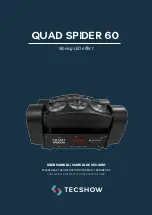
17
4. When the belt is properly tensioned, secure the adjustment
by tightening the two jam nuts against the frame.
5. Run the conveyor to make sure belt doesn’t slip and
remains running on track.
WARNING
Do not attempt to tighten the conveyor belt when
the Turf Tender is operating.
Belt Replacement
If it becomes necessary to replace the conveyor belt, use
the following procedure:
NOTE: DAKOTA sells replacement kits composed
of a spliced belt and wire splice pin. The splice pin
connects the two halves of the splice.
1. Run the conveyor until the belt splice is close to the front
of the Turf Tender; then shut the engine off.
WARNING
Make sure the engine is not running before starting
the belt replacement procedure.
2. Loosen the jam nut securing each of the two belt tensioning
bolts; then loosen the belt tensioning bolts. Make sure
you loosen each tensioning bolt the same number of turns.
3. Rotate the loose belt until the splice is at the front of the
Turf Tender.
4. Uncrimp or cut off the end of the belt splice securing the
hinge pin.
5. Using a steel rod, drive or push the hinge pin out of the
splice. The steel rod must be long enough to reach across
the entire belt.
NOTE: Once the hinge pin has started to exit the
splice, it may be easier to remove by pulling on it
with a pair of locking pliers.
6. Remove the old belt; then place the new belt into position
making sure the cups on the topside of the new belt have
the open part of the “C” facing to the rear of the Turf
Tender.
7. Align the splices of the new belt; then run the steel rod
(used to remove the hinge pin) through the splice.
MAINTENANCE
8. Using a crisscross pattern, tightening wheel bolts to 90
ft-lb (12.4 kg-m).
CAUTION
Do not under or over torque the wheel bolts.
Inappropriate wheel bolt torque will result in wheels
loosening and possibly falling off.
9. Place the wheel assembly back under the Turf Tender
and install the axle bolt. Tighten to 75 ft-lb (10.3 kg-m).
10. Remove the jack stands from beneath the Turf Tender;
then lower the jack.
NOTE: Wheel bolt torque must be checked every
10 hours after mounting a wheel until the bolts
maintain the proper torque.
HOPPER CONVEYOR BELT
Belt Adjustment
Due to stretching of the belting material with use, it will be
necessary to periodically tighten the conveyor belt. Pressure
on the belt and warm temperatures will increase the frequency
of belt tightening. The belt should be loosened if the Turf
Tender will not be used for an extended period of time or will
be moving to a colder operating temperature due to seasonal
or geographic changes.
NOTE: If the belt was loosened for storage or any
other reason, the belt will need to be tightened
before using the Turf Tender.
CAUTION
Always tighten the belt at the front roller. Adjusting
the rear roller will affect the material placement on
the twin spinners and may affect belt tracking.
To tighten the conveyor belt, use the following procedure:
1. Loosen the jam nut on each of the tensioning bolts.
2. Using a ¾ inch wrench, turn each tensioning bolt
clockwise 1-2 complete turns. Be sure to make equal
adjustments on both sides.
NOTE: Failure to adjust the belt equally on both
sides could result in improper belt alignment and
damage to the belt. If the belt doesn’t stay on track,
the belt may not be tightened equally on both sides.
3. Test the belt to see if it is properly tensioned.




































